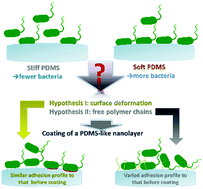当前位置:
X-MOL 学术
›
Mater. Horiz.
›
论文详情
Our official English website, www.x-mol.net, welcomes your
feedback! (Note: you will need to create a separate account there.)
A nanolayer coating on polydimethylsiloxane surfaces enables a mechanistic study of bacterial adhesion influenced by material surface physicochemistry†
Materials Horizons ( IF 12.2 ) Pub Date : 2019-09-02 , DOI: 10.1039/c9mh01191a Fei Pan 1, 2, 3, 4, 5 , Stefanie Altenried 1, 2, 3, 4, 5 , Mengdi Liu 1, 2, 3, 4, 5 , Dirk Hegemann 2, 3, 4, 5, 6 , Ezgi Bülbül 2, 3, 4, 5, 6 , Jens Moeller 5, 7, 8, 9, 10 , Wolfgang W. Schmahl 11, 12, 13 , Katharina Maniura-Weber 1, 2, 3, 4, 5 , Qun Ren 1, 2, 3, 4, 5
Materials Horizons ( IF 12.2 ) Pub Date : 2019-09-02 , DOI: 10.1039/c9mh01191a Fei Pan 1, 2, 3, 4, 5 , Stefanie Altenried 1, 2, 3, 4, 5 , Mengdi Liu 1, 2, 3, 4, 5 , Dirk Hegemann 2, 3, 4, 5, 6 , Ezgi Bülbül 2, 3, 4, 5, 6 , Jens Moeller 5, 7, 8, 9, 10 , Wolfgang W. Schmahl 11, 12, 13 , Katharina Maniura-Weber 1, 2, 3, 4, 5 , Qun Ren 1, 2, 3, 4, 5
Affiliation

|
To control material-associated bacterial infections, understanding the underlying mechanisms of bacteria and surface interactions is essential. Here we focused on studying how material mechanical and chemical properties can impact bacterial adhesion, using polydimethylsiloxane (PDMS) as a model material. To this end, PDMS surfaces of different stiffness were coated with a 2 nm highly cross-linked PDMS-like polymer film to confer comparable surface chemistry, while retaining similar mechanical properties for coated and uncoated samples. The uncoated samples showed increased interfacial adhesion force with the decrease of Young's modulus, whereas the nanolayer deposition yielded a comparable adhesion force for all surfaces. The Gram negative strains Escherichia coli, its fimbriae mutants and Pseudomonas aeruginosa as well as the Gram positive strain Staphylococcus epidermidis were analysed for their adhesion on these surfaces. For each bacterial strain similar numbers were found on the coated surfaces of different PDMS species, whereas the numbers on the uncoated surfaces increased several fold with the decrease of material modulus. Similar adhesion behaviour was also observed for the negatively charged abiotic polystyrene beads of similar size to bacteria. These results strongly suggest that the interfacial chemistry of the PDMS rather than the material mechanical properties plays a critical role in bacterial adhesion.
中文翻译:

聚二甲基硅氧烷表面上的纳米涂层可对受材料表面物理化学影响的细菌粘附性进行机械研究†
为了控制与材料相关的细菌感染,了解细菌和表面相互作用的潜在机制至关重要。在这里,我们以聚二甲基硅氧烷(PDMS)为模型材料,重点研究材料的机械和化学性能如何影响细菌粘附。为此,在不同硬度的PDMS表面上涂覆了2 nm高度交联的PDMS样聚合物薄膜,以赋予可比的表面化学性能,同时为涂覆和未涂覆的样品保留相似的机械性能。未涂覆的样品显示出随着杨氏模量的降低而增加的界面粘合力,而纳米层沉积对于所有表面产生了可比的粘合力。革兰氏阴性菌株大肠杆菌,其菌毛突变体和分析了铜绿假单胞菌和革兰氏阳性菌株表皮葡萄球菌在这些表面上的粘附性。对于每种细菌菌株,在不同PDMS物种的涂层表面上发现了相似的数目,而未涂层表面上的数目随着材料模量的降低而增加了几倍。对于与细菌大小相似的带负电荷的非生物聚苯乙烯珠,也观察到了类似的粘附行为。这些结果强烈表明,PDMS的界面化学而不是材料的机械性能在细菌粘附中起关键作用。
更新日期:2020-01-04
中文翻译:

聚二甲基硅氧烷表面上的纳米涂层可对受材料表面物理化学影响的细菌粘附性进行机械研究†
为了控制与材料相关的细菌感染,了解细菌和表面相互作用的潜在机制至关重要。在这里,我们以聚二甲基硅氧烷(PDMS)为模型材料,重点研究材料的机械和化学性能如何影响细菌粘附。为此,在不同硬度的PDMS表面上涂覆了2 nm高度交联的PDMS样聚合物薄膜,以赋予可比的表面化学性能,同时为涂覆和未涂覆的样品保留相似的机械性能。未涂覆的样品显示出随着杨氏模量的降低而增加的界面粘合力,而纳米层沉积对于所有表面产生了可比的粘合力。革兰氏阴性菌株大肠杆菌,其菌毛突变体和分析了铜绿假单胞菌和革兰氏阳性菌株表皮葡萄球菌在这些表面上的粘附性。对于每种细菌菌株,在不同PDMS物种的涂层表面上发现了相似的数目,而未涂层表面上的数目随着材料模量的降低而增加了几倍。对于与细菌大小相似的带负电荷的非生物聚苯乙烯珠,也观察到了类似的粘附行为。这些结果强烈表明,PDMS的界面化学而不是材料的机械性能在细菌粘附中起关键作用。











































 京公网安备 11010802027423号
京公网安备 11010802027423号